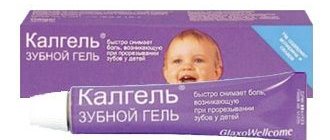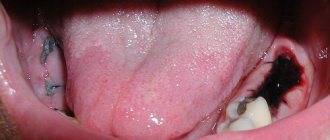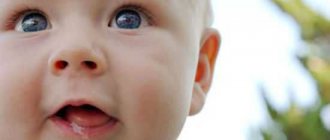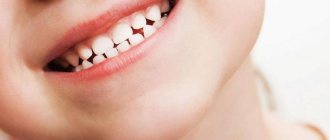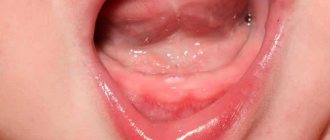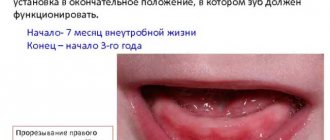What is edentia in children?
Adentia in children is a partial or complete absence of teeth due to their loss or abnormal development of the dental system. The disease is characterized by impaired chewing and speech function due to the lack of integrity of the dentition. In severe cases, dental edentia in children is accompanied by deformation of the facial skeleton and further loss of teeth. In the complete absence of teeth, there is often a displacement of the lower jaw towards the nose, retraction of the soft tissues of the pre-oral area, and the formation of wrinkles. With partial edentia in children, the remaining teeth shift and diverge. And in the process of chewing, an increased load falls on them.
Interesting fact!
The rudiments of baby teeth are formed in babies still in the womb, at about 3-4 months of pregnancy. The process of their formation takes about a month, so it is important that during this period the expectant mother consumes dairy products rich in calcium, without which the full formation and subsequent health of teeth is impossible.
When do the first teeth appear?
It is widely believed that a baby's first teeth should appear at six months.
If a child is 8 months old and has no teeth, parents begin to worry. Baby teeth begin to form in utero long before they become visible. Their rudiments appear already in the sixth week after fertilization. Over the next months, gradually, layer by layer, they are covered with hard enamel. A newborn's baby teeth are already formed.
A little later, roots begin to form. As they grow, they slowly push out the top of the tooth, which breaks through the gum. It happens that everything happens so quickly that the child is born with one or two teeth.
Newborn with teeth
The norm of the appearance of the first teeth
Usually, parents begin to look into the baby's mouth in search of the long-awaited tooth when he is 6 months old. Many of them soon find what they are looking for there. The rest patiently continue to carry out daily inspections. When a child turns 7 months old and still has no teeth, this is not a reason to worry. Most parents know this and therefore remain calm.
But when a baby doesn’t have a single tooth at 8 months, there is slight anxiety in the family. After all, everyone knows that from six to the beginning of the ninth month the incisor should appear. But should you? In fact, these norms are based on average statistics and are not a rule. There are cases when children are already born with several teeth, and it happens that the baby’s first incisor pecks only in the 9th or even 12th month of his extrauterine life.
Additional Information. In general, pediatricians advise parents not to panic if a long-awaited event drags on for up to 1.5 or even 2 years. Of course, provided that the rest of the baby develops normally.
Timing of the eruption process
There are average periods for the appearance of teeth, which are the norm.
Important! Each child is individual. It will be normal for a 4-month-old baby to erupt the first teeth and for a 10-month-old baby too.
Average terms:
- At birth, teeth are not visible. They are partially formed, but are located inside the gum;
- The first teeth appear on average between the fourth and seventh months (most often around 6 months of age). First, 4 central incisors emerge, two each below and above;
- At approximately seven or eight months, the 4 lateral incisors emerge;
- When a child is about a year old, his first 4 molars begin to grow. This leaves free space between them and the lateral incisors;
- This space contains 4 canines, which usually emerge at approximately 1 year and 4 months;
- At about 2 years of age, the second molars begin to grow;
- At the age of 3 years, a child should have all 20 baby teeth.
Teething pattern
Important! In children with late teething, they can all come out almost simultaneously.
Number of teeth at 8 months of age
For most children, the appearance of their first tooth becomes a pleasant surprise at the age of six months. Sometimes both lower incisors are shown at once. The upper central incisors erupt next. By the age of 8 months, the baby’s mouth is usually decorated with 4 teeth. And by one year – 8-12 teeth. All milk, namely 20 units, should appear by 3 years.
This is interesting: How to recognize pulpitis in a child?
Types of edentia in children
Edentia in children is divided into types in accordance with the criteria indicated in the table below.
| Criterion | Type of edentia | Characteristic |
Time of occurrence | Primary (congenital) | Absence of baby teeth in young children and permanent teeth in older children |
| Secondary (acquired) | Lost tooth after eruption | |
Number of missing teeth | Partial | Some teeth are missing |
| Full | All teeth are missing | |
Age period | Edentia of temporary occlusion | Appears during the eruption of baby teeth |
| Edentia of permanent dentition | Appears during the period when baby teeth are replaced by permanent teeth. | |
Reason for missing tooth | True edentia | There is not even a tooth germ in the jaw |
| False edentia (retention) | Delayed tooth development. There is free space where the tooth should be, and subsequently it erupts |
Consequences of early destruction of primary teeth
After the early removal of a baby tooth, the gum in its place becomes overgrown, and the permanent one is deprived of its natural landmark. This leads to phenomena such as:
- dystopia - eruption of a permanent tooth outside the dental arch;
- retention - the occurrence of a formed tooth in the thickness of the jaw bone.
If the baby tooth does not receive treatment, and the inflammatory process spreads to its roots, then the permanent follicle located under them is damaged. In this case, the permanent one may die, and then its place in the dentition will remain empty. The absence of a tooth is confirmed by radiography.
Causes of edentia in children
Edentia in children can be hereditary, but it can also develop during the child’s life. In this regard, there are several causes of dental edentia in children.
- Absence or death of tooth buds.
This may be due to hereditary reasons, as well as disturbances in the formation of the fetus in the womb. A child’s dental plate is formed during the prenatal period, and exposure to harmful factors (for example, poor environment or an unhealthy lifestyle of the mother) can negatively affect this process. - Loss of teeth during life.
Children, especially boys, due to their activity, are more susceptible to injury than adults. Thus, children’s teeth often fall out during fights, falls, and also when playing certain sports (hockey, football, boxing). - Deep caries and its complications.
Due to the thin enamel of baby teeth, caries in children develops on them much faster than on permanent ones. Therefore, if it is not treated in a timely manner, there is a risk of losing the tooth as a result of progressive purulent-inflammatory processes in the tissues.
Signs of the appearance of the first teeth
The process of the baby’s first teeth appearing in most cases has a number of distinctive features and is accompanied by many symptoms.
1. An increase in temperature can be observed from 1 to 3 days. In some babies, this phenomenon accompanies the teething process for up to five days. The thermometer can reach 39 degrees. To reduce body temperature, pediatricians prescribe various antipyretics to the baby.
2. Malaise and weakness can also accompany an important process. As a rule, this phenomenon is caused by an increase in temperature, as well as discomfort in the gum area.
3. Poor appetite is explained by the presence of painful sensations in the gums. During teething, doctors recommend giving your baby as much liquid and food of a similar consistency as possible.
4. Sleep disturbance.
5. Increased salivation.
6. Cough, runny nose. Cough is a consequence of increased salivation.
7. A constant desire to chew on various objects and suck a finger. During the period of teething, a small child practically does not remove his hands from the oral cavity.
It is very easy to confuse the above symptoms with signs of an incipient viral disease or cold. That is why it is very important to immediately consult a doctor if one of the symptoms is detected (especially if the temperature rises). The pediatrician will determine the true cause of the illness and prescribe treatment. Self-medication is strictly prohibited. This may harm the baby's health.
Treatment of adentia in children
Diagnosis of dental adentia in children is carried out by visual and palpation examination, targeted intraoral radiography and orthopantomography. The treatment tactics for adentia in children are determined taking into account the physiological, anatomical and hygienic characteristics of the child’s dental system. Depending on the degree of the disease, the following methods of treating adentia in children are used.
- Stimulation of teething.
In some cases, a procedure is used to dissect the gums and install special braces that stimulate teething.
- Fixed prosthetics.
The child is fitted with permanent orthopedic structures (crowns, bridges).
- Removable prosthetics.
Removable orthopedic structures (clasp, plate dentures) are installed.
- Dental implantation.
It is used only after the jaw bones are completely formed. This process is usually completed at the age of 18 for boys and at 16-17 years for girls. Until this time, edentulous treatment is carried out using removable and fixed dentures.
Reasons why there may be more teeth than normal at 8 months
There is another problem - parents think there are too many teeth. That is, a child at 8 months has grown more than 8 teeth. Is this really a pathology, and should parents worry?
There is no need to panic. When the first teeth appear after 3 months, this is an indicator of the norm. This happens if the expectant mother constantly takes prenatal vitamins or drinks them while breastfeeding. This is also possible in bottle-fed children. This means that the child’s body has enough microelements and essential substances.
This is interesting: Gel for gums during teething in babies: the best preparations for children from 3 months and older
It’s another matter when the first incisors appeared before 3 months of age. In this case, there is reason to suspect diseases of the endocrine system. You need to show your baby to a doctor and undergo an examination.
Consequences of edentia in children
If you do not consult a specialist in time and do not treat edentia in children, this can lead to deformation of the facial skeleton, which results in developmental defects in the child.
- Speech impairment.
With complete or partial absence of teeth, the child pronounces some sounds incorrectly, and may even lose the ability to pronounce them. - Chewing dysfunction.
Due to a decrease in the quality of chewing food and changes in food consumption patterns, missing teeth often leads to gastrointestinal diseases in a child. - Mental disorders.
Missing teeth is also a cosmetic defect. The baby is embarrassed to smile, and as a result he develops complexes. In addition, disturbances in the functioning of the jaws caused by edentia bring discomfort and cause deterioration in mood.
Causes
Previous infectious diseases can lead to disruption of eruption. Both the mother during pregnancy and the baby himself in the neonatal period can get sick.
Measles, rubella, and complications of influenza lead to improper formation of denta, enamel, and malformations of the tooth germ.
A lack of vitamin D in the body can lead to various types of bone development disorders. This is due to the fact that without a sufficient amount of this substance calcium is not absorbed. Its deficiency leads to fragility and deformation of bones, and impaired development of teeth.
Also, the reason for the toothless smile of an eight-month-old toddler may be endocrine system disorders, housing and communal services diseases, enzyme metabolism disorders, pituitary insufficiency and genetic disorders.
If parents or close relatives have problems with the thyroid gland, diabetes or other diseases, the pediatrician must know about this.
Against the background of a general delay in the child’s development, the appearance of incisors may also be delayed. And if during pregnancy a woman had problems with toxicosis, hormones, suffered serious illnesses, had bad habits, or simply did not receive a balanced diet, then it is worth taking the baby to the dentist.
He will assess the condition of the gums and, if there are any suspicions of abnormal development of tooth germs, he will give a referral for an x-ray. The absence of tooth buds is a very rare deviation that can only be diagnosed by a doctor.
Exposure to a harmful environment can also leave an imprint on a child's smile. Therefore, you should not get carried away with walks along the roads; it is better to breathe fresh air in a park or square.
But don't worry ahead of time. First of all, it is worth asking grandmothers about the timing of the eruption of the first incisor from the child’s parents. It happens that the timing of appearance and the nature of eruption are inherited by the toddler from adults. But more often it is very individual.
How much does treatment cost?
Treatment of adentia in children begins with an initial examination and drawing up a treatment plan. Typically, these services are provided free of charge - as a promotion to attract customers. Also, a small patient will need to have an x-ray at a cost of 350 rubles and a panoramic photograph of the oral cavity, the cost of which starts at 1,000 rubles. In addition, before starting treatment of adentia in children, it is necessary to carry out professional oral hygiene at a price of 2,700 rubles and more. Based on the fact that edentia in children is treated primarily by installing removable dentures, parents should be prepared for the following costs for various types of orthopedic structures: a partially removable laminar denture costs from 1,750 to 60,000 rubles, a complete removable laminar denture costs from 40,000 to 100,000 rubles, temporary complete removable denture - from 2,800 to 3,500 rubles. A removable acrylic prosthesis will cost from 12,000 rubles, a bridge prosthesis - from 25,000 rubles. The cost usually includes the manufacture of the structure and its installation by a specialist.
Examination and treatment
If a child has no teeth at 10–12 months, the pediatrician may prescribe an examination to determine the reasons for the delay. A panoramic x-ray shows whether there are baby tooth buds in the child's jaw. In case of partial edentia, specific treatment is prescribed to allow the embryos of permanent teeth to develop correctly. To ensure that the jaw is formed correctly and food is chewed efficiently, special removable dentures are made to compensate for missing baby teeth for a 3-year-old child.
The doctor may prescribe an ultrasound scan of the abdominal organs, blood tests, stool tests, urine tests of the child and others, if necessary. Vitamins and minerals are prescribed to strengthen the immune system, primarily vitamin D and calcium. The child should spend as much time as possible outdoors. He is given ring toys as a stimulant. A light massage of the gums with a clean finger is helpful.
Parents should be alerted if the incisors erupt too early, before 3 months. In some cases, this may indicate disorders in the endocrine system, but more often than not, early teething in children is an individual feature.
Before appearing from the outside, the incisor passes through the bone tissue surrounding it, and then through the mucous membrane of the gums. Do I need help with teething? Trying to speed up the process of its appearance with a piece of sugar, a spoon or other objects, you can damage the gums and introduce an infection into it.
According to a good ancient tradition, the one who discovers the child’s first tooth gives him a silver spoon. It is believed that she will bring him health and wealth. She can lightly tap the tooth and make sure that it has erupted and all anxious expectations are left behind.
When should you see a doctor?
Teething causes a lot of discomfort for the baby. This does not require medical attention. But there are situations when you cannot do without the help of a doctor. You should contact him in the following cases:
- Painful cough.
- The temperature does not subside for a long time.
- There is mucus and blood in the stool.
- Diarrhea
- and purulent nasal discharge.
- Constipation.
- Mouth ulcers.
- Unnatural color of the shoots.
Symptoms from teething hide the manifestation of diseases, for example, ARVI or infectious diseases. It is important to consult a doctor if negative symptoms occur. Exercise caution in such cases rather than regret later what you didn’t do.
How a dentist can help
If you are not ready to wait a year, seek help from a good pediatric dentist. The specialist will take an X-ray of the jaw to ensure the presence of tooth buds. If everything is fine, all you have to do is calmly wait for the process to begin - gum enlargement and increased salivation. Now it's time to help the baby:
- a ring stimulator will moderate itching, reduce discomfort and speed up teething;
- You can gently massage your child’s gums with a clean finger or a small spoon;
- stimulates tooth growth and fortified complementary foods - healthy juices and purees. While there are no teeth, solid complementary foods cannot be introduced.
This is interesting: What is a fistula on the gum: causes, what it looks like (photo)
If your health is fine
The timing of eruption depends on heredity, including grandparents, and on external factors. It is believed that in hot climates, teeth appear earlier, as early as 4 months. When a child is healthy and his development corresponds to his age, but there are still no teeth, although they should already appear in accordance with average standards, this causes concern among parents. Modern doctors indicate only approximate dates for the sequence of growth of the first teeth. The standard teething pattern looks like this: from 5–6 months - on each jaw there are 2 central incisors (first from below, then from above), from 8 months - lateral incisors, by the year the child has only 8 teeth. They are known to appear in pairs and alternately on both sides.
What to do if a child has only grown one tooth and there are no signs of a second one? You need to know that the sequence of teething may be different and this is not considered an anomaly. There are many options for their appearance. At seven months they can erupt 2 - from below, then 1 - from above, then the third and fourth - in the bottom row, and only after them the missing top one.
Many mothers tend to associate the whims of a 3-4 month old child, poor sleep or appetite with the imminent appearance of the first incisors. There is no doubt left if the baby also puts everything into his mouth and drools profusely. Sometimes it seems to mothers that the gums are already red; they look into the child’s mouth in the hope of seeing that swollen white ball from which the long-awaited tooth is about to emerge. But days and weeks pass, the child is already 7 months old, and there are no teeth? No need to panic.
If the baby’s health is fine, you just need to wait, especially since all the dates are individual and there may be deviations in one direction or another for six months. Some children have their first incisors at 4 months, while other babies can already walk by the time they begin to emerge.
Types of appetite disorders
Anorexia in a child may manifest itself as:
- hyporexia – loss of appetite;
- hyperrexia – its increase in appetite;
- Bulimia – uncontrollable desire for food. With this disorder, the child is not able to control the volume and composition of food eaten;
- anorexia - almost complete refusal to eat. One of the most dangerous violations. Can lead to dire consequences: organ dystrophy, metabolic disorders and even death;
- pararexia – a significant change in taste preferences. The child may have a desire to eat something that is not eaten, for example, chalk or clay. Pararexia often indicates the absence of an element (calcium, potassium, iron, etc.) that is extremely necessary for the child’s body in the daily diet.


